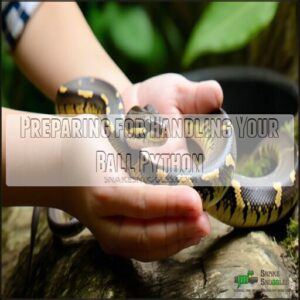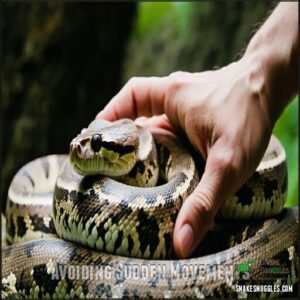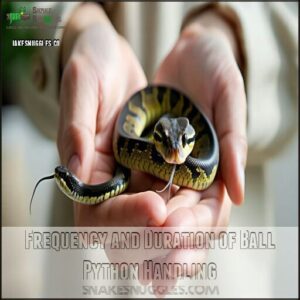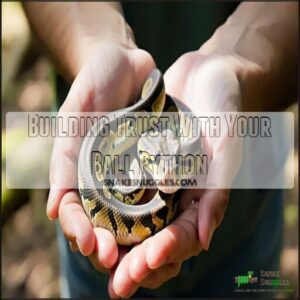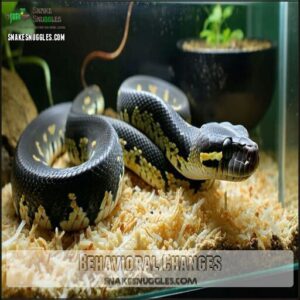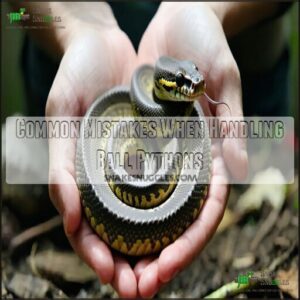This site is supported by our readers. We may earn a commission, at no cost to you, if you purchase through links.
 Ball pythons don’t “like” being handled in the way a dog enjoys belly rubs, but many tolerate it well if done correctly.
Ball pythons don’t “like” being handled in the way a dog enjoys belly rubs, but many tolerate it well if done correctly.
Their natural instinct is to feel secure, so gentle handling can help them feel less stressed over time, and look for signs like relaxed muscles and calm behavior to gauge their comfort.
Always approach slowly, support their whole body, and avoid handling right after feeding or during shedding, as overhandling can cause stress.
Keep sessions short and infrequent at first, and with patience, you’ll build trust and create a positive experience for both you and your snake. Ready to learn more?
Table Of Contents
- Key Takeaways
- Do Ball Pythons Enjoy Being Handled?
- Preparing for Handling Your Ball Python
- How to Safely Handle a Ball Python
- Frequency and Duration of Ball Python Handling
- Building Trust With Your Ball Python
- When to Avoid Handling Your Ball Python
- Recognizing Signs of Stress in Ball Pythons
- Benefits of Handling for Ball Python Health
- Common Mistakes When Handling Ball Pythons
- Creating a Positive Handling Experience
- Frequently Asked Questions (FAQs)
- Can a ball python be handled too much?
- Why do people handle ball pythons?
- Do ball pythons enjoy being picked up?
- Is handling a ball python stressful for them?
- How often should a ball python be handled?
- How should I handle a ball python?
- Do ball pythons like being petted?
- Do ball pythons like to be cuddled?
- Are ball pythons easy to handle?
- What happens if you handle a ball python too quickly?
- Conclusion
Key Takeaways
- Ball pythons don’t naturally enjoy handling, but many can tolerate it with proper care – look for signs like relaxed muscles and calm behavior to gauge their comfort.
- Keep handling sessions brief (10-15 minutes) and infrequent (1-3 times weekly), always supporting their entire body and moving slowly to avoid triggering defensive responses.
- Never handle your snake during shedding, within 48-72 hours after feeding, or when showing signs of illness as these are particularly stressful times for them.
- Build trust gradually through consistent routines, positive associations, and by respecting their body language – if they show signs of stress like hissing, tight coiling, or escape attempts, return them to their enclosure immediately.
Do Ball Pythons Enjoy Being Handled?
Ball pythons don’t naturally enjoy being handled, but many can tolerate it with proper care.
Understanding their behavior and individual personality is key to making interactions comfortable for both you and your snake.
Natural Behavior of Ball Pythons
Ball pythons are the introverts of the reptile world, thriving on solitude and quiet.
Their natural behaviors are shaped by survival instincts, not a dislike for interaction. Understanding this is key to respecting their needs.
- Nocturnal Activity: They explore at night when it’s safer from predators.
- Solitary Habits: They spend up to 23 hours daily hidden in burrows or dense vegetation.
- Exploration Behavior: They investigate their surroundings during calm, undisturbed moments.
Their shyness stems from millions of years of evolution, not temperament. While naturally cautious, ball pythons are docile when handled respectfully, making patience essential for positive snake handling.
Individual Snake Personalities
Not all snakes are the same—ball pythons have unique temperament variations that shape their handling preferences.
Some are naturally docile, calmly tolerating interaction, while others are more reserved, preferring minimal contact.
These differences stem from genetic predispositions and early experiences, making each snake’s behavior distinct.
You might notice a curious one exploring your hand or a shy one retreating.
By understanding your ball python’s temperament and respecting its comfort zone, you can create positive, stress-free snake handling experiences suited to its personality.
Signs of Comfort During Handling
Understanding your snake’s body language is key to successful ball python handling.
A relaxed body and slow movements often signal comfort.
You might notice your python stretching out rather than curling tightly, which shows it feels safe.
Here are three signs of snake trust and comfort:
- Curious exploration with gentle tongue flicking, tasting the air calmly.
- Normal breathing—no rapid huffing or defensive sounds.
- Seeking contact by wrapping around you lightly without tension.
By providing proper support and a quiet environment, you’ll encourage these positive behaviors during snake handling.
Benefits of Regular Handling
Regular ball python handling isn’t just about taming—it’s about improving their quality of life and yours.
Over time, handling reduces fear by helping your snake associate interaction with safety, not threats. This builds trust and makes tasks like health monitoring or vet visits much easier.
Handling ball pythons also provides exercise benefits, keeping their muscles strong and preventing obesity. Think of it as a mini workout for them! Plus, the mental stimulation they get from exploring outside their enclosure can break the monotony of their solitary routines.
Enhanced bonding is another perk. While snakes don’t form emotional attachments like mammals, consistent, gentle interaction makes them more predictable and tolerant. Snake handling benefits include spotting health issues early, like unusual lumps or shedding problems. With patience and proper techniques, you’ll create a stress-free, enriching snake handling interaction both you and your python can appreciate.
Preparing for Handling Your Ball Python
Preparing to handle your ball python is like setting the stage for a smooth performance—it all starts with thoughtful preparation. A little planning goes a long way in ensuring a stress-free experience for both you and your snake.
Here’s what to do before handling:
- Wash your hands with unscented soap to remove food odors. This simple step prevents your python from mistaking your fingers for a snack.
- **Pick the right time.
** Avoid handling during their acclimation period, after feeding (wait 48–72 hours), or when they’re shedding. Choose quiet moments when your snake is relaxed.
- **Prepare the space.
** Use a safe enclosure or handling space free of pets, loud noises, or escape risks. Keep the room temperature between 75–85°F for their comfort. A clean environment, proper scent removal, and a secure handling area are cornerstones of ball python care. It’s also important to maintain a clean terrarium to prevent the spread of bacteria. These snake handling tips help build trust and safety.
How to Safely Handle a Ball Python
Handling a ball python safely starts with understanding its needs and body language.
By using gentle movements and proper support, you can guarantee a calm and stress-free experience for both you and your snake.
Proper Hand Washing Techniques
Keeping your hands clean is a simple yet essential part of snake handling hygiene. It protects both you and your ball python from harmful germs and potential issues like salmonella.
Here’s how to do it right:
- Wet your hands with lukewarm water—hot or cold water can reduce soap’s effectiveness.
- Use antimicrobial soap, lathering for at least 20 seconds, and focus on nail hygiene by scrubbing under your nails.
- Rinse thoroughly to remove all soap residue.
- Dry your hands completely using a clean towel or disposable paper towel.
If soap and water aren’t available, hand sanitizer with at least 60% alcohol is a good backup. To further minimize risks, consider the importance of consistent hygiene practices and consistent hygiene practices.
Proper hand washing isn’t just a snake handling precaution—it’s key to snake handling safety, reducing stress, and preventing unwanted snake bites.
Approaching The Snake Correctly
A gentle approach is key when handling ball pythons.
Always move with slow movements to avoid startling them, as quick actions can trigger defensive ball python behavior.
Keep your hands visible in their line of sight and approach from the side, not above, to respect their natural instincts.
Maintain a calm demeanor to create a stress-free environment.
Proper hand placement is vital—never grab the head or tail.
By using thoughtful snake handling techniques, you’ll foster trust and guarantee a positive handling experience.
Supporting The Snake’s Body
Supporting your ball python’s body properly is essential for safe and stress-free handling. Always make certain weight distribution is balanced and avoid applying pressure.
Here’s how to achieve a secure hold:
- Place one hand under the first third of their body, just behind the head.
- Use your second hand to support the midsection for snake support.
- For larger pythons, add a third point of contact near the tail.
- Keep your grip firm but gentle, avoiding sudden squeezing.
To improve comfort, consider specialized handling tools. This proper grip prevents injury as well as helps your python feel secure, encouraging trust during handling sessions.
Avoiding Sudden Movements
When handling ball pythons, sudden movements can make them feel threatened, leading to stress or defensive reactions. A slow approach and predictable actions are key to keeping your snake calm and comfortable.
Here’s how to master controlled handling:
- Move gently and deliberately—quick gestures can startle your snake.
- Keep a calm environment—reduce loud noises or sudden distractions.
- Use a steady, supportive grip—firm enough to feel secure but never tight.
- Let your python adjust gradually—don’t rush shifts between hands or surfaces.
- Signal your intentions—approach slowly to avoid startling them.
Think of it like moving through water—smooth, flowing motions build trust while respecting ball python behavior. Gentle movements make snake handling stress-free for both of you.
Recognizing Signs of Stress
When handling your ball python, watch for stress signals like hissing, striking, or escape attempts.
If your snake balls up tightly, tucks its head, or makes jerky movements, it’s showing discomfort.
Regurgitation after handling can also indicate stress.
Calm ball python behavior includes smooth movements, loose coils, and gentle tongue flicks.
Pay attention to snake body language—stress signals are your pet’s way of saying it needs a break.
Recognizing snake stress helps you create a safe, comfortable handling experience while respecting its natural instincts, and this is key to a good handling experience.
Frequency and Duration of Ball Python Handling
Handling your ball python the right amount is key to keeping it comfortable and stress-free.
Knowing how often and how long to handle them helps build trust while respecting their natural instincts.
Recommended Handling Sessions Per Week
Balancing your ball python’s need for solitude with your desire to interact is key.
Aim for 1–3 handling sessions per week, adjusting based on their temperament and stress levels. Some snakes enjoy more frequent handling, while others thrive with less. Pay attention to their cues—if they seem tense or avoidant, it’s time to back off.
Consistent handling helps them build trust and familiarity with human interaction.
- Weekly Frequency builds trust without overwhelming them.
- Handling Benefits include reduced fear and better bonding.
- Tailor sessions to their Individual Needs.
- Respect their natural behaviors for Stress Reduction.
- Fit handling into your Owner Schedule thoughtfully.
Ideal Length of Handling Sessions
The ideal handling duration for ball pythons is 10–15 minutes per session.
This timeframe helps balance their need for environmental stability with safe, stress-free interaction.
Overextending sessions can lead to snake stress, so always pay attention to their behavior.
Watch for these behavioral cues during handling:
- Muscle tension: A relaxed ball python feels soft and supple; stiff muscles suggest discomfort.
- Breathing patterns: Calm, steady breaths mean they’re comfortable; rapid breathing signals stress.
- Movement style: Slow, curious exploration is a good sign, while frantic movements show unease.
Shorter, consistent sessions are better for stress reduction than infrequent, lengthy ones.
Always support their body evenly and avoid sudden movements.
By respecting their limits, you’ll guarantee positive experiences and build trust over time.
Adjusting Handling for Young Ball Pythons
Young ball pythons need a gentle introduction to handling to match their delicate nature and developing temperament. Start by giving your new snake 1–2 weeks to settle into its enclosure before any interaction.
Once ready, keep handling sessions short—5 to 10 minutes, no more than three times a week. Frequent handling, when done carefully, helps them adapt faster to human interaction.
Always use both hands to support their entire body. Young snakes have fragile spines, so avoid letting them dangle unsupported. Pay attention to their body language—balling up tightly or rapid breathing are signs of stress.
By focusing on short sessions and proper body support, you’ll help your ball python grow comfortable with handling, setting the stage for calm, confident interactions later.
Balancing Handling With Feeding Schedule
Timing is everything when balancing ball python handling with feeding.
To avoid stress and health issues, follow these tips:
- Regurgitation Risk: Wait 48–72 hours after feeding before handling to let digestion finish.
- Scheduled Interaction: Limit handling to 1–3 times a week to maintain a healthy routine.
- Digestion Time: Watch for signs like a food bulge or sluggish behavior before handling.
If your snake seems full or stressed, skip handling.
Instead, try handling alternatives like spot cleaning or gentle enclosure interaction to build trust.
Building Trust With Your Ball Python
Building trust with your ball python takes patience and consistency. By respecting its boundaries and creating positive handling experiences, you can help it feel secure and comfortable over time.
Consistent Handling Routines
Consistency is key when building trust through ball python handling.
A regular handling schedule, like setting specific days and times, helps your snake feel secure and familiar with interactions.
Stick to short sessions, gradually increasing handling duration as your snake becomes more comfortable.
This gradual introduction builds a positive association with your presence, reducing stress over time.
Remember, routine benefits both you and your snake—think of it as a trust-building ritual.
By keeping interactions predictable, you’ll encourage calm, confident behavior during each session.
Positive Reinforcement Techniques
Building trust with your ball python takes patience, but positive reinforcement can make handling smoother.
Rewarding calm behavior encourages your snake to associate handling with positive outcomes. Try these techniques:
- Offer small treats after handling sessions to reinforce good behavior.
- Use clicker training to mark desired actions, like staying relaxed.
- Incorporate Target Training with a stick to guide movements gently.
- Practice gradual introduction to handling for more reserved snakes.
- Pair handling with scent association to create familiarity.
Stay observant and consistent—your snake’s comfort grows with each interaction, making handling a stress-free experience over time.
Creating a Stress-Free Environment
Creating a stress-free environment is key to your ball python’s comfort and trust during handling.
A calm, predictable space helps minimize disturbances and reduce signs of stress.
Here’s how you can set it up:
- Quiet Handling Space – Keep the enclosure in a low-traffic area, away from loud noises or sudden movements.
- Hiding Places – Add multiple hide boxes so your snake has safe spots to retreat when needed.
- Temperature Gradient – Maintain a consistent range of 76–90°F to mimic their natural habitat.
- Humidity Control – Guarantee levels stay between 50–60% for ideal health and comfort.
By prioritizing snake comfort and stress reduction, you’ll create an environment that encourages calm, positive interactions.
Recognizing and Respecting Snake’s Boundaries
Respecting your ball python’s boundaries is key to building trust. Pay attention to their body language and stress signals during handling.
| Behavior | What It Means | How to Respond |
|---|---|---|
| Tight coiling | Feeling threatened | Place them down gently |
| Rapid breathing | Stress or fear | Stop handling |
| Calm tongue flicking | Comfortable exploration | Continue carefully |
Choice-based handling lets your snake decide when they’re ready. Use a gentle approach, and always provide a safe space for them to retreat. Recognizing stress signals helps create positive experiences and strengthens your bond over time.
When to Avoid Handling Your Ball Python
Knowing when not to handle your ball python is just as important as knowing how to handle it.
Times like shedding, after feeding, or when it’s unwell can cause unnecessary stress for your snake, and knowing these situations is crucial to avoid harming your pet.
During Shedding Periods
When your ball python is shedding, it’s best to skip handling altogether.
Shedding discomfort makes them sensitive, and their eyesight impairment during this time can lead to stress or defensive behavior.
You’ll notice shedding signs like cloudy, bluish eyes, dull skin, or increased hiding.
They may also refuse food and react defensively when approached.
To help, focus on keeping their enclosure humid (70–80%) and disturbance-free.
Think of it as giving them a spa day—quiet, calm, and all about comfort.
- Signs your snake is about to shed:
- Bluish, cloudy eyes
- Gray, dull skin
- Hiding more often
- Reduced activity
- Defensive reactions to touch
After Feeding
After meals, handling ball pythons can upset their digestion, increasing the regurgitation risk—a stressful and dangerous event.
Give your snake a handling delay of 48–72 hours post-feeding to guarantee a smooth digestion period. Observe signs like relaxed coiling, occasional shifts, and tongue flicks before resuming interaction. Remember, food size and activity levels affect digestion speed, so always prioritize your snake’s comfort.
Here’s a quick reference:
Time Post-Feeding Activity
**Handling Allowed?
| ** | Reason | ||
|---|---|---|---|
| 0–24 hours | Resting | No | Digestive process begins |
| 24–48 hours | Minimal movement | No | Risk of regurgitation |
| 48–72 hours | Gentle exploration | Yes | Digestion likely complete |
| 72+ hours | Normal activity | Yes | Safe for handling |
Patience guarantees your ball python stays healthy and stress-free!
When Snake Shows Signs of Illness
Handling your ball python when it’s sick isn’t just a bad idea—it can worsen its condition.
Instead, keep an eye out for these snake signs that point to illness:
- Respiratory issues like wheezing, open-mouth breathing, or bubbling around the nostrils.
- Lethargy signs such as unusual stillness, appetite changes, or hiding excessively.
- Regurgitation causes including improper digestion or stress from recent handling.
- Scale abnormalities like blisters, discolored patches, or retained shed.
When your snake shows these symptoms, avoid handling to prevent further stress on its immune system.
Observe its behavior from a safe distance, and document anything unusual.
A vet visit is your best move to guarantee snake health and recovery, giving your pet the care it needs.
During Breeding Season
Breeding season, typically in fall and winter, brings noticeable changes in ball python behavior. During this time, their focus shifts to reproduction, and handling ball pythons should be minimized to avoid stress.
Hormonal changes, nesting behavior, and breeding stress can affect their temperament and actions. Reduced handling during this period helps maintain their well-being.
Here’s a quick guide:
| Behavior | Meaning | Handling Advice |
|---|---|---|
| Restlessness | Searching for a mate | Reduce handling |
| Food refusal | Normal courtship phase | Avoid force-feeding |
| Defensive posturing | Hormonal shifts | Provide extra space |
After breeding, focus on post-breeding care to guarantee your snake returns to its usual calm temperament. This care is crucial for the snake’s well-being and to prevent any long-term effects from the breeding season. By following these guidelines and minimizing handling, you can help ensure a healthy and stress-free environment for your ball python during the breeding season.
Recognizing Signs of Stress in Ball Pythons
Understanding your ball python’s stress signals is key to keeping it happy and healthy.
By learning to spot changes in behavior or body language, you can guarantee handling stays safe and stress-free.
Body Language Indicators
Your ball python’s body language is the key to understanding its comfort level during handling.
Stress signals like hissing, defensive postures, and escape attempts shouldn’t be ignored.
Here are five critical cues to watch for:
- S-shaped defensive posture – A sign your snake feels threatened and might strike.
- Curling into a tight ball – Indicates fear and a need to retreat.
- Erratic movements – Suggests high anxiety and discomfort.
- Hissing or puffing – A clear warning to stop.
- Tense muscles with rapid tongue flicking – Reflects unease.
Relaxed movements, slow tongue flicking, and calm coiling show your snake feels safe and at ease.
Behavioral Changes
Changes in your snake’s behavior can speak volumes about its comfort level during handling.
If your usually calm ball python starts refusing meals, hides excessively, or flicks its tongue erratically, it’s time to reassess your approach.
These shifts often point to stress from handling frequency, environmental changes, or improper techniques.
A defensive coil or sudden strike isn’t just “attitude”—it’s a clear stress signal.
Pay attention to these temperament shifts to prevent long-term issues.
| Behavior | Possible Cause | Action Needed |
|---|---|---|
| Refusing meals | Stress or diet impacts | Adjust handling schedule |
| Defensive striking | Handling discomfort | Shorten sessions, move gently |
| Excessive hiding | Poor acclimation period | Guarantee a secure environment |
Recognizing these patterns helps you build trust and improve your ball python’s temperament over time.
Physical Symptoms of Stress
Spotting stress in your ball python is key to safe handling.
Look for these physical signs during interactions:
- Muscular Tension: A stiff body or curling into a tight ball.
- Breathing Changes: Heavy breathing or audible hissing.
- Defensive Postures: Striking or recoiling without provocation.
- Regurgitation Risk: Vomiting food after handling.
These behaviors mean your snake feels unsafe.
Gently return it to its enclosure to relax.
Respecting stress signals during snake handling builds trust and prevents harm to your python’s well-being.
Long-Term Effects of Chronic Stress
Chronic stress in ball pythons can quietly chip away at their health, leading to serious long-term consequences.
While they may seem fine at first, prolonged stress impacts multiple systems, reducing their overall lifespan and well-being.
Here’s how stress affects your snake over time:
| System Affected | Short-Term Effects | Long-Term Damage |
|---|---|---|
| Immune System | Minor infections | Severe immune suppression |
| Growth and Digestion | Feeding refusal | Growth inhibition, digestive issues |
| Reproductive | Delayed breeding attempts | Permanent reproductive issues |
You might notice behavioral changes, such as constant hiding, defensive postures, or refusal to eat.
These are your snake’s way of saying, “I’m not okay.”
Overhandling or improper ball python handling practices often trigger these issues.
The good news? Adjusting handling frequency, respecting your snake’s temperament, and creating a stress-free environment can help reverse many effects.
Prioritize their welfare to keep them healthy and happy.
Benefits of Handling for Ball Python Health
Handling your ball python isn’t just about bonding; it can also support their health.
Regular interaction offers gentle exercise, reduces fear, and lets you check for any potential health issues.
Physical Exercise and Stimulation
Handling your ball python isn’t just bonding—it’s a chance for exercise and mental stimulation.
Their natural behaviors, like curling and climbing, get a boost, improving muscle toning and mental acuity.
Make handling fun with enrichment opportunities:
- Use climbing structures or textured surfaces for habitat variety.
- Support their body fully to encourage safe, natural movement.
- Move slowly to reduce stress and enhance snake behavior awareness.
- Limit handling sessions to 10–15 minutes for controlled activity.
Short, enriched handling sessions keep your snake healthy and engaged!
Opportunity for Health Checks
Ball python handling isn’t just about bonding—it’s a great way to check your snake’s physical health.
Regular snake handling inspections help with early detection of issues that might need attention.
While handling, take a moment to assess your python’s condition:
- Scale condition – Look for flaky, dry, or damaged scales.
- Parasite identification – Check for mites, ticks, or other pests.
- Injury assessment – Notice any lumps, bumps, or unusual swelling.
- Respiratory health – Watch for wheezing, open-mouth breathing, or mucus.
These quick checks during handling keep your ball python healthy and happy!
Reducing Fear of Human Interaction
How do you help your ball python feel safe during handling? Start by creating a Safe Space with minimal noise and distractions.
Use Gradual Exposure to handling, allowing the snake to adjust at its own pace. Practice Scent Familiarization by letting it explore your hands calmly.
A Calm Demeanor and steady movements reduce stress. Over time, your snake will build a Positive Association with handling, making interactions smoother and fear-free for both of you.
Bonding Between Snake and Owner
Building a bond with your ball python is all about patience and understanding their unique temperament.
Snakes don’t form emotional connections like mammals, but they can develop trust through consistent, positive interactions.
Here’s how to strengthen your human-snake interaction:
- Support their body during handling to make them feel secure and reduce anxiety.
- Handle regularly but in short sessions to foster habituation benefits without overwhelming them.
- Recognize their scent and movements—over time, they associate your presence with safety.
- Watch their behavior for signs of stress or curiosity, adjusting your approach as needed.
With mutual trust and positive association, your ball python will become more comfortable, making handling a rewarding experience for both of you.
Common Mistakes When Handling Ball Pythons
Handling a ball python might seem simple, but common mistakes can lead to stress or even harm for your snake.
By avoiding errors like overhandling or ignoring their body language, you can create a safer, more comfortable experience for both of you, which is crucial for a positive interaction with your snake.
Overhandling
Overhandling can upset your ball python’s natural rhythm, leading to stress and behavioral issues.
Snakes aren’t social creatures, so too much interaction might cause negative associations like defensive behavior or fatigue. Pay attention to stress indicators like tight coiling, rapid breathing, or attempts to escape.
To protect your snake’s welfare, limit handling frequency and keep sessions short.
- Overstimulation: Frequent handling can overwhelm and exhaust them.
- Health consequences: Increased risk of regurgitation after meals.
- Behavioral issues: Stress may lead to hissing or biting.
- Negative associations: Excessive handling can erode trust over time.
Improper Support Techniques
Supporting your ball python properly avoids stress and potential harm.
One common mistake is relying on the tail to hold or restrain them. This creates spinal stress, muscle strain, or even injuries.
Instead, focus on good weight distribution: use one hand to support the midsection and the other under the tail. Keep your grip steady but gentle—imagine you’re holding a fragile object, not squeezing a soda can.
Leaving parts of their body unsupported can lead to dropping hazards, which might injure your snake. Good snake handling isn’t about control; it’s about creating safety and balance.
By preventing improper support, you’ll build trust and make handling easier for you both over time.
Ignoring Snake’s Body Language
Ignoring snake body language during ball python handling can lead to defensive behaviors and bite risks.
Stress indicators like rapid breathing, tight coiling, or escape attempts show discomfort. Pay attention to these signs:
- Rapid breathing or coiling tightly—Your snake feels overwhelmed.
- Hissing or sudden movements—They’re uneasy and need space.
- Striking posture or raised body—Stop handling immediately to avoid harm.
Understanding snake comfort guarantees handling safety and builds trust with your ball python.
Observing their tongue flicking behavior can reveal their level of comfort and curiosity.
Handling During Inappropriate Times
Timing matters with ball python handling, and knowing when to back off can save you both trouble. Shedding handling irritates their sensitive skin, making them defensive. Feeding handling risks regurgitation—a messy, dangerous situation. Illness handling and rehoming handling should focus on essentials only, as stress worsens their condition.
Overhandling risks turning a calm snake into an aggressive one. Watch for signs of stress like tight coiling or hissing; they’re your python’s way of saying, “Not now!”
Here’s a quick guide:
| Situation | Impact | Best Action |
|---|---|---|
| Shedding Handling | Irritation, defensiveness | Avoid completely |
| Feeding Handling | Regurgitation risk | Wait 48 hours |
| Illness Handling | Health decline | Limit interaction |
| Overhandling Risks | Aggression, stress | Reduce contact |
Respect their limits!
Creating a Positive Handling Experience
Creating a positive handling experience for your ball python starts with ensuring their comfort and safety.
By setting up a calm environment and using proper techniques, you can help your snake feel secure during interactions.
Setting Up a Safe Handling Area
Creating a safe handling area guarantees your ball python stays calm and secure.
A stress-free environment starts with thoughtful preparation and attention to detail.
- Secure Environment: Use an escape-proof enclosure that’s easy to access.
- Cleanliness Protocol: Keep the area clean and free of clutter to prevent accidents.
- Minimal Distractions: Choose a quiet spot with soft lighting and no sudden noises.
- Temperature Control: Maintain consistent warmth and humidity for comfort.
- Escape Prevention: Always supervise handling to avoid unexpected escapes.
A well-prepared snake handling environment helps your ball python feel safe, making each interaction more comfortable for both of you.
A suitable habitat includes a proper python enclosure for safety.
Using Proper Handling Equipment
Using proper equipment makes handling ball pythons safer and easier.
A hook vs. hands approach works well for nervous snakes, letting you guide them gently.
If you’re worried about bites, consider gloves or not—it’s a personal choice but useful for beginners.
The right equipment, like a quality reptile hook, can substantially improve safety.
Snake bags are ideal for secure transport, while enclosure tools like escape-proof lids keep your python safe.
Always use cleaning equipment to sanitize tools and prevent contamination.
| Equipment | Purpose | When to Use | Benefits |
|---|---|---|---|
| Snake Hook | Guiding and lifting | Nervous or defensive snakes | Hands-free interaction |
| Handling Gloves | Protection | Nervous handlers | Prevents bites/scratches |
| Snake Bag | Secure transport | Vet trips or travel | Keeps snake secure |
| Cleaning Tools | Sanitizing equipment | After handling or feeding | Prevents disease spread |
These reptile handling tips guarantee stress-free experiences for both you and your ball python!
Incorporating Enrichment Activities
Incorporating enrichment activities into ball python handling can boost mental wellbeing and encourage natural behaviors.
By adding variety and sensory stimulation, you’ll create a more engaging experience for your snake.
Try these ideas for snake handling enrichment:
- Rotating Objects: Offer PVC pipes, hides, or new textures for exploration.
- Interactive Items: Introduce paper bags or soft fabrics to pique curiosity.
- Environmental Design: Add climbing branches or rocks for natural movement.
- Food Challenges: Hide treats in snake-safe containers to promote problem-solving.
These environmental enrichment methods make handling sessions more enjoyable for both you and your snake.
Gradually Increasing Handling Duration
Start with short, gentle sessions—5–10 minutes is perfect for building trust and easing your ball python into handling.
Watch their body language; smooth movements and relaxed muscles signal comfort.
Gradually extend the handling duration to 15–30 minutes as they adjust, but always respect their limits.
Here’s a quick guide:
| Handling Aspect | Beginner Stage | Progressive Stage |
|---|---|---|
| Session Length | 5–10 minutes | 15–30 minutes |
| Handling Frequency | 1–2 times per week | 2–3 times per week |
| Comfort Levels Observed | Relaxed, curious | Calm, exploratory |
Consistency is key.
Handle them at the same times weekly to build familiarity.
Younger snakes may need shorter sessions due to age considerations.
By respecting their comfort levels and increasing snake handling frequency gradually, you’ll foster trust and achieve positive outcomes.
Frequently Asked Questions (FAQs)
Can a ball python be handled too much?
Think of handling a ball python like borrowing a friend’s car—too much use can cause wear.
Overhandling stresses them out, so stick to 1–3 sessions weekly, keeping interactions short and respecting their signals.
Respecting their boundaries is key to a healthy and stress-free relationship with your ball python.
Why do people handle ball pythons?
People handle ball pythons to build trust, reduce the snake’s stress, and make care easier.
It’s also a way to observe their behavior up close, ensuring they’re healthy and comfortable in their environment.
Do ball pythons enjoy being picked up?
Picking up a ball python is like cradling a cautious explorer.
They don’t "enjoy" it like a pet dog might, but with gentle handling, they can tolerate it and even associate it with positive experiences.
Is handling a ball python stressful for them?
Handling a ball python can be stressful if it’s done too often, too long, or during shedding or after feeding.
Watch for signs like curling into a ball or trying to escape to avoid discomfort.
How often should a ball python be handled?
Ball pythons, known for spending up to 23 hours hidden daily, thrive when handled 1–3 times a week.
Keep sessions under 15 minutes, respect their mood, and skip handling after meals or during shedding.
How should I handle a ball python?
Gently support your ball python’s entire body with both hands, avoiding sudden movements.
Limit sessions to 10–15 minutes, and watch for stress signs like curling into a ball.
Handle calmly to build trust over time.
Do ball pythons like being petted?
Imagine petting a ball python—sounds intriguing, right?
While they tolerate gentle touches on their body, they don’t enjoy it like mammals.
Avoid their head and tail, and always watch for signs of stress.
Do ball pythons like to be cuddled?
Ball pythons don’t enjoy cuddling like a cat or dog might.
They tolerate being held if handled gently and feel secure, but their solitary nature means they prefer quiet, stress-free environments over prolonged close contact.
Are ball pythons easy to handle?
Yes, ball pythons are generally easy to handle due to their calm and docile nature.
With gentle, consistent handling and attention to their body language, they can become comfortable and tolerate interactions well.
What happens if you handle a ball python too quickly?
Handling a ball python too quickly can stress it out, leading to defensive behaviors like hissing or striking.
It might also hide or refuse food.
Always move slowly, giving it time to feel secure.
Conclusion
Let’s face it—your ball python isn’t dreaming of cuddles, but with patience, it can learn to tolerate handling.
By understanding their natural instincts and respecting their boundaries, you’ll create a stress-free routine that benefits both of you.
Watch for signs of comfort, like relaxed muscles, and avoid overhandling or stressful situations.
Do ball pythons like being handled? Not exactly, but with the right approach, they can adapt, making handling a positive and rewarding experience.
- https://www.quora.com/Do-ball-pythons-like-to-be-held-and-petted
- https://www.reptileforums.co.uk/threads/new-owner-ball-python-doesnt-seem-to-like-being-handled.1079018/
- https://community.morphmarket.com/t/to-handle-or-not-to-handle-that-is-the-question/42388
- https://ball-pythons.net/forums/showthread.php?252273-quot-Loves-quot-Being-Handled
- https://www.youtube.com/watch?v=rIiDuN3lOt4


